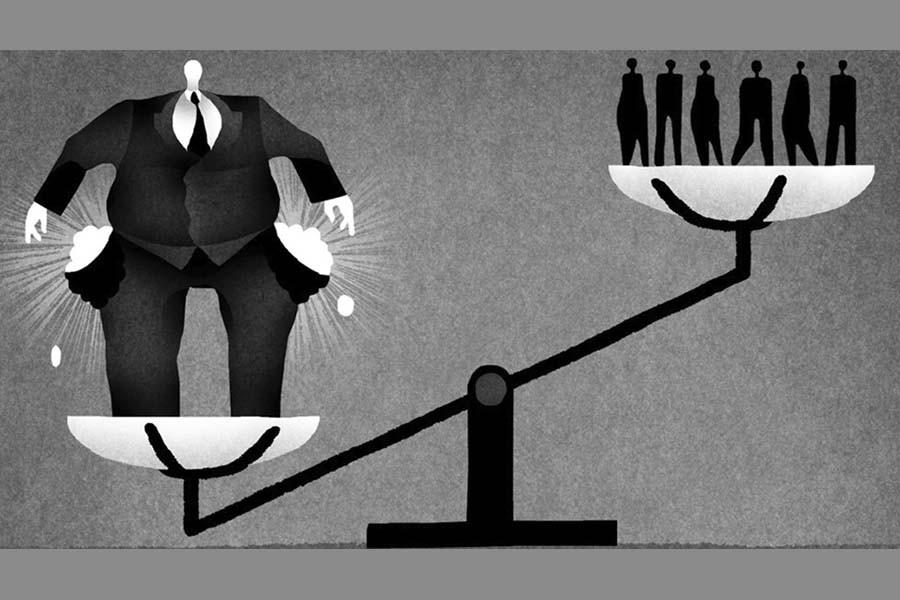
Published :
Updated :

Concerns are being expressed over the increasing inequality in the country since 1990s. There is apparent lack of 'distributive justice' so that everyone gets the benefits of the growth. Such inequality, alongside the country's economic growth, is creating social instability and imbalance.
In fact, economic inequality has been rising alarmingly in Bangladesh, especially in the urban areas. The Gini coefficient (a statistical measure of distribution) has risen to 0.483 in 2016, which was 0.467 in 2005 and 0.458 in 2010. It means rich people here are gradually becoming richer. One major concern is that the annual rate of decline in poverty has reduced to 1.2 per cent. In the 7th Five Year Plan the target is to maintain the status quo of Gini coefficient that is 0.458. But unfortunately inequality could not be reduced.
Analysts say it is impossible to ensure growth with equity, if the pace of urban and rural development is not the same. There is moral degradation in many areas, and moral standards must be improved to make the country's development sustainable.
According to statistics, the share of national income has increased among top 10 per cent of the population, and decreased among the lowest 10 per cent. Social and moral degradation is responsible for the increase in wealth of the rich. The rate of tax paying people is not increasing, as some rich people do not pay taxes as they are required to, while some of them avoid taxes. The government gets only 12 per cent tax which is 50-60 per cent in many countries.
According to the Household Income and Expenditure Survey (HIES) carried out by the Bangladesh Bureau of Statistics recently, poor people's share in national income eroded further in the past six years, with the richer segment having bigger stakes.
The poorest five per cent had 0.78 per cent of the national income in their possession back in 2010, and now their share is only 0.23 per cent. In contrast, the richest five per cent, who had 24.61 per cent of the national income six years back, now has a higher share of 27.89 per cent. It shows the extent of concentration of household income by the higher household income group.
The HIES 2016 also focussed on income shares of the bottom half (on economic scale) of the population to show that they used to command 20.33 per cent of the national income in 2010 but it has now fallen further to 19.24 per cent. In other words, income of the people on higher economic scale has increased over the past six years since the last HIES was conducted in 2010.
Particularly, the top 10 per cent of the population (in terms of economic standing) is now having more income share (38.16 per cent) compared to what they had (35.84 percent) in 2010. On the contrary, the lower echelon (bottom 10 per cent of the population) now has half (just 1.01 per cent) the income share it had (2.0 per cent) in 2010.
Country's farm sector growth remains somewhat stagnant. The government must take measures to create jobs to take the benefits of the growth to all segments of the population. However, the growth in the manufacturing sector is more capital-intensive, technology-driven and labour-displacing. The service sector growth also benefits the skilled and IT-savvy people more than the others.
While incomes from manufacturing and services have grown, employment growth has been weak. Thus labour income growth has been weaker than the growth of gross domestic product (GDP).
Farm sector growth should be accelerated and the landless people need to be shifted to more skilled areas of production. More investment in farm research and development should be made so that more crops are grown on less land. The beneficiaries of the safety net programmes have to be chosen carefully. Besides; the government has to invest in human capital development and put emphasis on the quality of education rather than quantity.
Due to the existing economic, social and environmental disparities, the ambition of attaining inclusive growth in Bangladesh is facing enormous challenges. The government took quite a number of initiatives for overall development of the country. But absence of appropriate laws, inadequate implementation of existing laws, corruption, and above all, various social stigma and negative mind-sets have inhibited access to equal opportunities by all citizens of the country.
Vulnerabilities of the people get aggravated due to the lack of education and skills, inadequate health services, religious and ethnic differences, adverse geographical locations, economic deprivation, life cycle status, physical and mental disabilities, gender and transgender disparities, civil identity and lack of rule of law.
The adoption of Sustainable Development Goals (SDGs) have created the opportunity for individuals and communities falling behind to raise their voices. However, there is a lack of good governance and accountability in the country and targets mentioned in the SDGs will not be achieved without ensuring good governance.
There is no denying the fact that rising income and wealth inequality has affected growth and created social unrest and disrupted socio-political and economic stability in the country. Development has to be viewed from the perspective of the people falling behind.


 For all latest news, follow The Financial Express Google News channel.
For all latest news, follow The Financial Express Google News channel.